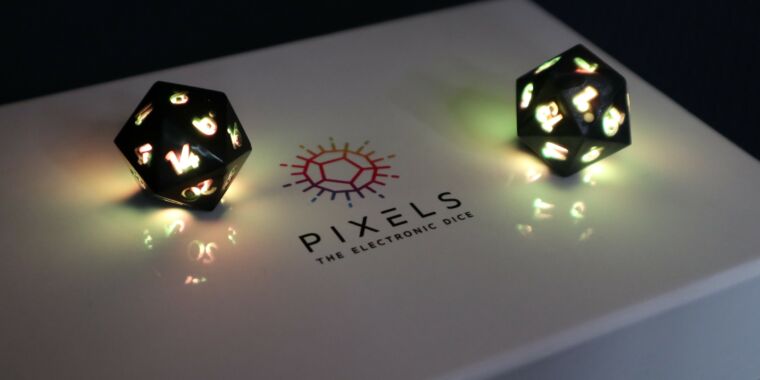A light show for every crit: How good are the $39 Pixels “smart” dice?
[ad_1]
-
The Pixels Dice, special pre-alpha edition, as tested by Sam Machkovech.
Sam Machkovech -
Want to dim all but the top number for a sad “womp, womp” moment when you roll the lowest amount possible? That’s an option.
Sam Machkovech -
Or customize a natural 20 roll with an explosion of animated, scattered lights.
Sam Machkovech -
Happiness and misery, side-by-side.
Sam Machkovech -
Same scene, internal lighting disabled. That’s a bit dim, so keep clicking.
Sam Machkovech -
The “hematite gray” version, lights disabled. This is an entirely smooth die, and the shapes inherent are from the way the resin set. Nothing about this die is chipped. (The two dots are a visual reminder that this is the side you want to place against the charging coil.)
Sam Machkovech -
The “onyx black” version. Similar color. However! This one is chipped on its 20 face.
Sam Machkovech
Oh, Kickstarter: the land of wild, wacky promises and broken dreams, where products that could’ve been imagined during a productive shower or a psychedelic trip can become a reality, logistics and physics be damned. As we’ve written and seen, however, it’s a dangerous space for consumers, so much so that Kickstarter warns customers that it’s not technically a “store.” You give Kickstarter money, and it gives you the potential to receive goods or services.
Hence, we prefer to test a mid-Kickstarter product before telling you about it, and that’s the case for Pixels Dice, as seen in the above shiny-and-alluring images. Full of sensors, LEDs, and Bluetooth functionality, these dice sounded like the smartest addition to a tabletop game I’d ever seen when they contended for the 2019 Hackaday Prize. Upon getting my hopes up, I emailed their creator a cold-call request: whenever Pixels Dice actually exist, I want to test their sales pitch.
One very long year later, a package showed up at my door, and it contained two prototype, 20-sided Pixels Dice—currently priced at $39 per die, or $199 for a seven-dice set. Now that the project’s Kickstarter is live, and (as of press time) teetering towards $3 million in sales, I wanted to share my prototype testing experience, along with my somewhat optimistic take on what to expect from the final version, currently estimated to ship in “March 2022.”
Critical hit, now with critical light
As described on their Hackaday project site, Pixels take the board-gaming convention of multisided dice, then add six electronic components: a Bluetooth controller, an array of RBG LEDs, an accelerometer, a battery, a wireless, inductive-charging coil, and onboard memory.
Your imagination might immediately run wild with the sum total of those components, as squished inside gaming dice, and creator Jean Simonet is bullish about their gaming potential in his sales pitch. The obvious biggie is LED light-show possibilities with every roll of the dice, as paired with accurate roll tracking. Roll a 20 (a “crit” in D&D-speak), and your die could explode in a sensational light show. Roll a 1, on the other hand, and your die could light up with the visual equivalent of a sad trombone. Roll anything in between, and each face of the die can light up with its own colors and animations, as chosen by you.
Speaking of: should your dice be synced to a nearby Bluetooth device, your dice rolls could trigger sound effects via a compatible app. Maybe you’d prefer a literal “womp womp” sound, or maybe someone at your table would benefit from the dice-roll number being spoken out loud, or tracked in a D&D-style journal, by a companion app.
Having picked through my share of high-end dice bins at nerdy conventions, I don’t flinch at the idea of spending $39 on a single, blinged-out die. $199 for a full set is another matter, however. And in my testing of Pixels thus far, that’s where I currently draw the line. The prototypes I’ve played with include a mix of strengths and annoyances, tolerable enough for a single-die investment, or maybe even a pair. But I hesitate to dump an entire set’s worth of confidence into a $199 Kickstarter preorder.
Not bad at first LED blush
All of my tests were conducted using Pixels’ nonfinal prototype hardware, which only came in D20 flavors; they’ll eventually come in other popular polyhedral flavors (6-sided, 10-sided, etc.). Anything I describe below could be improved by at least one more year of development, iteration, and testing. Anything could turn out worse in the final product, as well, once the line moves from handcrafted, one-of-a-kind prototypes to products manufactured at scale. For the rest of this article, I will call these prototypes Pixels.
When I unboxed and began rolling Pixels, I skipped syncing to any Bluetooth devices to see how the dice had been set up by Simonet (he personally packaged and shipped these suckers). I learned that each die had its own light-animation template saved onto its memory, and both revolved around a simple ruleset: one general light-show animation for numbers 2-19; a “sad” animation for 1, and a “celebratory” animation for 20. It always recognized a 20 or a 1 precisely; exactly how it measured the other numbers, I couldn’t determine with this template.
Boom: basic sales pitch achieved. If I’d bought these at a store with zero customization options, I’d think that was a fine starting point in terms of unique, high-tech dice. Still, I came to realize the preinstalled animations were not quite up to my tastes. In particular, when Pixels’ light-show animation fills every die’s face, it can be hard to quickly see which number is showing on the top—and you don’t want to be the person at your table making everyone strain their eyes for 2-4 seconds of flashy animations to figure out what you just rolled.
As a result, I’m already keen on recommending Pixels’ opaque-body models (which I’ve tested) over the transparent ones (which I haven’t). These LEDs run pretty bright, and having those lights emerge through cut-out numbers is crucial for readability as it is. I can’t imagine trying to parse a Pixel die roll’s results with more transparent plastic absorbing and showing more obfuscating light.
[ad_2]
Source link




